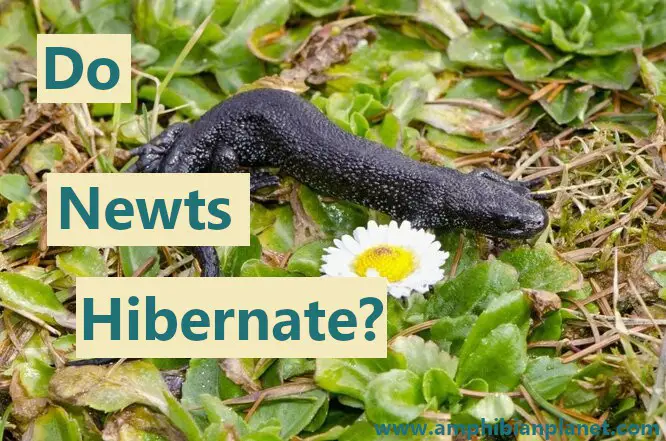In the winter, we do not see many newts and salamanders. This is because they are ectothermic (cold-blooded) animals, meaning they can not regulate their internal body temperature. When the environmental temperatures rise or fall, so does their internal temperature. So where do newts go in the winter?
All newts hibernate to protect themselves from freezing temperatures in the winter. This could be under logs, in thick leaf litter, or small underground burrows below the frost line. Some newts, such as the red-spotted newt occasionally hibernate on the bottom of ponds (underwater).
However, not just any random pond will do. The water needs to have lots of dissolved oxygen, and not freeze all the way to the bottom. The newt can then get all the oxygen it needs by absorbing oxygen from the water through its skin, allowing it to stay underwater all winter long.
Newts Technically Don’t Hibernate, They Brumate
I just told you newts hibernate right? Well, that’s a slightly inaccurate term. The correct term is “brumate.”
Hibernation is a term that is only reserved for endothermic (warm-blooded) animals. Brumation refers to basically the same thing in cold-blooded animals, but with some differences.
The Differences Between Hibernation and Brumation
Hibernation |
Brumation |
| Hibernation is voluntary | Brumation is involuntary |
| Hibernating animals still require lots of oxygen | Brumating animals have extremely low oxygen requirements. |
| Hibernating animals are not easily disturbed by temperature fluctuations and sleep through most of the winter | Burmating animals are easily disturbed by fluctuations in temperature and will be active on warm days in the winter |
Hibernation is when an endotherm (warm-blooded animal) such as a squirrel voluntarily reduces its activity and enters a state of dormancy to conserve energy when sufficient food is not available. During hibernation, the body temperature falls, and the heart and breathing rate slow down.
Brumation, on the other hand, is when an ectotherm (cold-blooded animal) such as a salamander or newt involuntarily enters a state of dormancy when the temperatures fall.
Cold-blooded animals cannot regulate their internal body temperature, so they are forced into dormancy when the temperatures fall.

A significant difference between hibernation and brumation is the oxygen requirements of the animal. Although hibernating animals have reduced oxygen requirements, they still need lots of oxygen to survive. In contrast, brumating animals have extremely low oxygen requirements.
This makes it possible for newts (and some frogs) to stay underwater all winter long without having to resurface to breathe air.
Also, hibernating animals sleep through most of the winter (although to do occasionally wake up). Burmating animals on the other hand will be active on warm days of the winter. If the weather is mild, they may come out of dormancy and bask in the sun before re-entering dormancy.
However, despite these differences, I will stick to the well-known term “hibernation” to keep things simple. When I use the word “hibernation”, you know I really mean “brumation” ;).
Newts “Bulk-Up” to Prepare for Hibernation
Newts will instinctively know to start preparing for hibernation when the temperatures start to drop and winter approaches.
They will typically start to eat more than normal to “bulk-up” on their fat reserves and put on good body weight before entering dormancy. However, when they are very close to hibernation, they become less active completely stop eating.
When the winter comes, newts will go to their preferred hibernacula (hibernating spots). Since there are so many species of newt, the exact place a newt will hibernate will depend on the species.
Most Newts Hibernate on Land
Most newts, such as the rough-skinned and the great crested newt, will typically hibernate on land.
This could be;
- Under rocks, logs, piles of rubble, paving slabs
- Deep inside thick leaf litter or compost heaps
- Inside deep cracks in rocks or logs, and in the foundations of old buildings
Some newts may also hibernate in underground burrows. Since newts cannot dig their own burrows, they look for abandoned small mammal burrows that are deep enough that the frost does not penetrate all the way to the bottom.

The most ideal hibernaculum (hibernating space) is somewhere damp (so the newt does not lose too much moisture through its skin), that stays frost-free all winter.
Sometimes, Newts Will Hibernate in Ponds
Some newts such as the smooth newt and the red-spotted newt will occasionally hibernate at the bottom of ponds among leaf litter.
However, not just any pond will do, the pond needs to be deep enough so it does not freeze all the to the bottom. It also needs to have lots of dissolved oxygen so the newt can efficiently breathe underwater all winter long.

Unlike most other animals, newts do not burrow down into the mud when they hibernate underwater. This is because when underwater, newts breathe entirely by absorbing oxygen that comes in contact with their skin. So if their skin is buried in mud, their breathing is obstructed.
Some newts may even occasionally swim around in the water during hibernation.
How Long Do Newts Hibernate?
Most newts only hibernate for 2-3 months before they get active again. However, great crested newts very frequently hibernate for up to 5 months.
Sometimes, newts will prematurely emerge from hibernation due to a brief warming period, but then the temperatures rapidly drop. This is known as “winter kill”, and as the name suggests, is often fatal for the newt.
Spring Temperatures Bring Newts Out of Hibernation
When the winter ends and the warm spring temperatures arrive, newts will come out of hibernation. Most newts will only emerge when the temperatures reach over 5°C (41°F), so if the weather is still chilly, they may take a little longer to emerge.
In great crested newts, males will typically emerge before the females and migrate to breeding ponds to wait for the females to arrive. Once the females arrive, they will mate and lay their eggs.
Unlike “true salamanders” or frogs, newts do not lay their eggs in masses. Rather, female newts wrap each egg with the leaf of a pond plant using their back legs.
They do this to protect the eggs from predators, such as frogs, or larger salamander larvae.
Some Newts Estivate in the Summer
Cold winter temperatures aren’t the only thing newts have to worry about. The hot and dry summer weather is just as undesirable. This is where estivation (also spelled as aestivation) comes in.
Estivation is when an animal enters a state of dormancy in order to conserve energy when the enviromental conditions are very hot and dry.
The breathing rate, heart rate, and general metabolic rate all decrease, just they do in hibernation. Think of it as some sort of summer hibernation.
If the summer weather gets too harsh, newts will find a cool moist place and estivate as they wait for the rain to come and the temperatures to drop. If the rain comes, but the temperatures remain high, they will not emerge until the temperatures are cooler.
Captive Newts Do Not Need to Hibernate
In the wild, newts hibernate of out necessity. When the temperatures are low, they have no choice but to go into a state of dormancy and hibernate.
However, captive newts are usually kept in a controlled environment with optimal unchanging temperatures. This means they do not need to hibernate as wild newts do.
Still, if a captive newt is not kept in a controlled environment, it will hibernate when the temperatures drop just like it would in the wild.
To help a captive newt hibernate;
- Provide it with a deep enough substrate that it can burrow and hide.
- Prove lots of where the newt can hide.
Remember, wild newts usually hide under rocks or logs to hibernate. Captive newts need to be provided with something that most closely replicates that environment.
Wild newts will come out of hibernation when the warm spring temperatures come. In captivity, you can encourage your newt to come out of hibernation by gradually increasing the temperature and humidity levels in its habitat.
How to Help Wild Newts Hibernating in Your Pond or Garden
If you have newts that frequently hibernate in your pond or garden, there are a few things you can do to help them.
- Build artificial hibernacula in your garden- Hiberacula simply refers to places where newts can safely spend the winter.
You can easily provide artificial hibernating space by pilling wood, rubble, or compost, then covering it with turf to provide a moist space that will be protected from the frost.
- If you see newts hibernating in your pond, regularly clear the surface of the pond- When newts hibernate underwater, they need to absorb oxygen through their skin.
If your pond is covered in snow, it will be dark under the water, stopping submerged plants from creating oxygen through photosynthesis.
Make sure your pond plants are getting enough light to photosynthesize and create oxygen. Newts will not survive for long if the oxygen content of the water gets too low.
Be careful not to touch or disturb the newts when carrying out your maintenance works.
What to Do if You Disturb a Hibernating Newt
If you find a hibernating newt, it’s best to leave it alone. But, if you have already disturbed it, just return it where you found it and it should be fine.
If you are not able to put it back where you found it, place it in a similar hibernating space that is moist enough, is protected from predators (such as cats), and is protected from the frost. This could be in a log pile or deep inside a compost heap.
The most important thing is; the hibernaculum you chose shouldn’t be warm, it should just be protected from the frost.
Frequently Asked Questions:
Question: Can Newts Freeze to Death?
Answer: If the temperatures suddenly drop before newts can prepare for hibernation, they can freeze to death.
Also, if a newt prematurely comes out of hibernation during a brief warm period in winter, it can freeze to death if the temperatures drop before it can go back to its hibernaculum. This is known as “winter kill” and is fairly common.
Question: What Do Hibernating Looks Look Like?
Answer: Most hibernating newts may look dead and won’t move at all. They sometimes won’t even react, or will only move very little when you touch them.
Final Thoughts
Newts survive winter by taking cover and hibernating in places protected from the frost. In the summer, they may go into estivation which is basically “summer hibernation” when the environmental conditions are harsh.
Captive newts typically do not need to hibernate because they are kept in a controlled environment with constant temperatures.
If you see a hibernating newt, it’s best to leave it alone. When the warm spring temperatures come, it will come out of hibernation, and most likely look for a pond to breed in.


